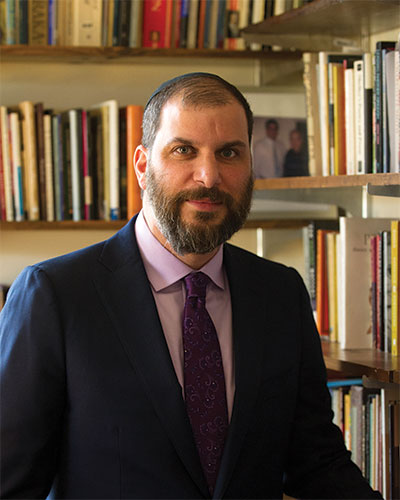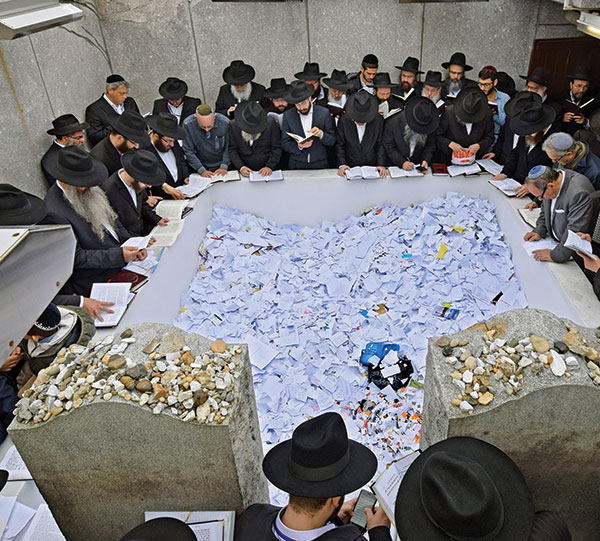Ba’al Teshuvah Poetics
To be a ba’al teshuvah—a Jew who turns (literally, returns) to some form of Orthodoxy—is, David Caplan shows us, to be caught between ambivalence toward the past and reluctance about the future. “Any more is fanaticism / any less is heresy,” he writes in “Causeway,” a poem from his second collection, Into My Garden. In these poems, Caplan addresses us as if from a narrow space, barely wide enough to accommodate a single person, singing the depths and ambiguities of the spiritual moments he inhabits.

Although the stories behind Caplan’s autobiographical poems are veiled in abstraction, it is clear that he has returned to Jewish tradition through the gateway of Chabad-Lubavitch, and his poems are imbued with the symbolism and mythology of that particular subculture. Indeed, the most memorable poems in the collection focus on contemporary Lubavitcher practices, whether it’s playing chess on Christmas Eve or learning Hasidic teachings on the phone while driving. The value of Caplan’s work is not anthropological; it is literary and psychological. He has rendered the complex inner experience of becoming a contemporary Hasid in decidedly un-Hasidic language. Indeed, Caplan’s poems are powerful and surprising, in part, because they are written in the familiar introspective and confessional first-person voice of late-modern American lyric poetry. Take, for instance, “Into My Garden (II):”
All week they studied what he is about to say.
Born after his death, they want more than stories,
want to feel how it felt to be in that room,
stand with the old men he blessed for long lifeand listen.
Under the white tablecloth, a handkerchief
wrapped around his hand bound his soul.
I have come into My garden, My sister, My bride . . .Projected across the study hall, downloaded
and captioned, he closes his eyes and explains.
This may be the first (and last) poem ever written about the ritual of watching a “rebbe video,” a recording of the seventh and last Lubavitcher Rebbe, Menachem Mendel Schneerson, with his followers. To those familiar with such proceedings, all of the allusions are clear, right down to the handkerchief, which is held during particularly powerful teachings so that the soul of the speaker does not expire in the rapture of the moment. Indeed, “Into the Garden” is the title of a seminal 1950 discourse, Basi l’gani, by the previous Lubavitcher Rebbe—a manifesto of Chabad philosophy formulated as a mystical interpretation of the verse that opens the fifth chapter of the Song of Songs.
On the surface, the poem’s opening line is clear: It describes studying the Lubavitcher Rebbe’s exposition of his predecessor’s teaching and then watching an old video of him explaining this very teaching. But Caplan’s description is, I think, deeper and more personal. The line’s peculiar phrasing creates a warped sense of time: How could one study that which is only now about to be said? In that single moment of expectation, past and future swap places. Suddenly, the poem is no longer about the video. Caplan is pointing to a metaphysical side effect of being a ba’al teshuvah: To be a ba’al teshuvah, “a master of return,” is to come back to a past that isn’t one’s own, an aspirational past that is entirely imagined.
And yet a ba’al teshuvah’s real past can also be the antidote against fanaticism. In the poem, this is demonstrated by Caplan’s ability to draw out the ritual’s bizarre juxtapositions. The narrator and his community are gathering to witness their rebbe being channeled—in both the technological and ancient senses of that word. But, as he is channeled, he’s also packaged, just another bit of content to be captured and captioned. Caplan’s hard enjambment on the word “downloaded” drives that point home in the poem’s closing lines: “Projected across the study hall, downloaded / and captioned, he closes his eyes and explains.” The moment feels both sacred and somehow trite (and very 21st century).
Caplan is a distinguished literary scholar at Ohio Wesleyan University. In his 2004 book, Questions of Possibility: Contemporary Poetry and Poetic Form, he questioned the division between formalist and experimental poetry. More recently, he has written about rhyme in hip-hop. Into My Garden, however, is not a collection that moves across forms. Nearly all of the poems are written in the same controlled lyric voice, with a generally uniform rhythm, stanza, and line length. Caplan’s previous poetry collection, In the World He Created According to His Will, had a wider variety of voices, styles, and themes, and yet, perhaps because of the narrowing of the form and subject, the poems in Into My Garden hold more emotional intensity.
A desire for wholeness courses through this collection, which isn’t surprising. Part of being a ba’al teshuvah is the yearning to stop being one—to finally blend with those who never had to return because they never left. Caplan’s testimony is a rare glimpse into the inner world of such a person in transit.
Perhaps there is something inherent to the experience of a Chabad initiate that especially invites this form of reflection. Chabad followers ritually mythologize and sacralize not only the distant, irretrievable past of Jewish history but also a past that is so recent it borders on the present. That includes, above all, stories of Hasidic rebbes and their close associates, all the way up to the Lubavitcher Rebbe’s final years. And while it is more typical to recount piety, grit, and communal living on the way toward spiritual wholeness, Caplan writes about his own private journeys, often presented through the lens of an ambiguous “we,” as in the striking poem “Before the City,” set in Montefiore Cemetery, in Cambria Heights, Queens.
The need to be heard does not change,
the need to get close. Again we tear
our request, scatter it across the grave.
The first time we came we only knew
what to ask for, not what to do: knock
before entering to clear some room,
fast before knocking. Before the city,
before the slow time of waiting,
stones crown the two tombstones,
a wedding invitation spotted with rain,
a letter after letter read aloud.
Just as the righteous are greater in death,
a marriage without children counts
backward, the gray light measuring
a skyline of torn paper, white stone.

Montefiore Cemetery is the site of the Lubavitcher Rebbe’s grave, where his followers have continued to gather since 1994. Caplan’s choice of indirect narrative and allusion creates a sense of distance from the experience, yet his devotion comes through clearly, too. The stones on the tombstone are seen as a “crown” and are an affirmation of the royalty the narrator feels is bestowed by the followers who continue to come, himself among them.
The center of the poem is a simple and striking phrase: “a letter after letter read aloud.” The passive voice of the phrase emphasizes an auspicious absence, or at least vagueness as to who is reading these letters. Is it the people who’ve written them and come to recite their messages out loud? That’s the first, obvious answer. But the immediately preceding image in the poem seems to imply something surreal: The rain is doing the reading, even as it is slowly consuming the text (“letter after letter” even sounds like pitter-patter). There is, of course, a third possibility as to who the reader of all these letters is—a possibility that is left unspoken but is the actual intention of the journey. Does the narrator experience his letters as being read? Is it possible that all three meanings somehow weave around each other to evoke a moment that is fraught with ambiguity?
Caplan’s avoidance of a direct description of the experience may signify a desire to somehow universalize it, to sift through the specifics, retaining only a trail of images that do not require the insider knowledge, blurring the moment’s edges to give the poem a more mystical, diffuse sense. Or is it that Caplan is reticent to describe, directly, his communing with the deceased leader of an ultra-Orthodox group—a ritual that is controversial even within the Orthodox world—to readers of modern poetry, his academic colleagues, and, perhaps, his past self?
Whatever one may think of Caplan’s pilgrimage and his image of the crown of stones—a stone’s throw from the crown of thorns—the spiritual experience he describes will be familiar to ba’alei teshuvah and other spiritual seekers. The beauty of Caplan’s book is that it is not polemical. It does not set out to win an argument or ask you whether you’ve put your tefillin on today. These gentle poems invite the reader into one person’s profound, ambiguous religious experience.
Suggested Reading
Haim Gouri at 90
The poet turned 90 last fall, and his latest poems are among the best he has ever written.
Poems Like Mountains
“I was a year old,” Rivka Miriam says, “and my father would hold me in his arms and throw me up and down and I laughed and laughed and laughed. Each time he threw me up he’d yell in Yiddish ‘Rivkela Rivkela where’s Savta?’ ‘Killed.’ ‘Rivkela Rivkela where’s Miriam?’ ‘Killed.’ ‘Rivkela Rivkela where’s Chaim?’ ‘Killed.’ He’d say all the names…

A Complex Network of Pipes
You couldn’t know Yehuda Amichai without being struck by the casual way in which original and sometimes startling metaphors dropped from him in ordinary conversation. It wasn’t done for effect. It was just the way his mind worked. One thing made him think of another and what it made him think of was generally something that would not have occurred to anyone else.
Mystical Teachings Do Not Erase Sorrow
In Yehoshua November’s new collection, however, it turns out that the difficulties of being a Jewish poet do not primarily flow from being either Jewish or a poet but from the underlying difficulties of life itself.
Comments
You must log in to comment Log In